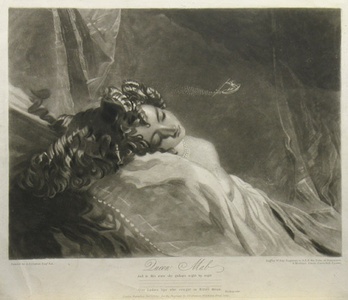| Method | Mezzotint |
| Artist | William Say after Alfred Edward Chalon |
| Published | London Published Feby, 1st 1827 for the Propietor by J. Dickenson, No. 114, New Bond Street |
| Dimensions | Image 190 x 255 mm, Sheet 250 x 309 mm |
| Notes |
Below title reads the inscription extracted from William Shakespeare's Romeo and Juliet: And in this state she gallops night by night............... O'er Ladies lips who straight on Kisses dream. A woman reclining on a bed, asleep, with Queen Mab, as a small fairy, flying towards her in a tiny boat. Queen Mab is a fairy referred to in Shakespeare's play Romeo and Juliet. She also appears in other 17th century literature, and in various guises in later poetry, drama and cinema. In the play her activity is described in a famous speech by Mercutio written in iambic pentameter, in which she is described as a miniature creature who drives her chariot into the noses and into the brains of sleeping people to compel them to experience dreams of wish-fulfillment. She would also bring the plague in some occasions. She is also described as a midwife to help sleepers 'give birth' to their dreams. William Say (1768-1834) went to London in 1788 and studied under engraver and painter James Ward. In 1807, he engraved William Beechey's portraits of the Duke and Duchess of Gloucester, to whom he was then appointed engraver. Over his lifetime, Say produced a total of 335 plates, which included works after old masters as well as contemporary artists. In around 1819, he produced the first ever mezzotint engraving on steel. Say's son Frederic Richard Say was a successful portrait painter. Alfred Edward Chalon (1780-1860) was a portrait and subject painter born in Geneva to French parents. His father became a professor at the Royal Military College in Sandhurst, and the family moved to England. In 1797, Chalon enrolled at the Royal Academy schools. He first exhibited at the academy in 1810; was elected an associate two years later and became an academician in 1816. Chalon's talents lay in painting miniature watercolour portraits. His work became highly fashionable. He came to the attention of Queen Victoria and she asked him to paint her first visit to the House of Lords in 1837. Afterwards, the queen appointed him as painter in watercolour. The head and shoulders of this portrait were featured on many British colonial postage stamps. Ex. Col.: Hon. Christopher Lennox Boyd. Condition: Trimmed to platemark. |
| Framing | unmounted |
| Price | £200.00 |
| Stock ID | 24854 |

